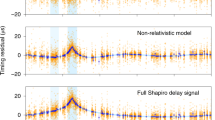Abstract
PULSARS are believed to produce high energy particles. If high energy protons produced by the pulsar strike a target, say a binary companion, high energy neutrinos are produced in the collisions. At the same time, schemes for detecting high energy neutrinos produced in nature are currently being considered (refs 1–4 and K. Lande, personal communication). Here we point out that binary systems containing moderately young pulsars (ages T < 104 yr, that is comparable to NP0532) may emit high energy neutrinos (1012 < Eγ < 1014 eV) at detectable levels. Such pulsars are assumed to have total luminosities of the order 1038 erg s−1. Discussion of feasible neutrino telescopes (such as/the deep underwater muon and neutrino detector, DUMAND1–4) suggests that fluxes from point sources as small as 102−1 eV cm−2 s−1 in high energy neutrinos may eventually be detectable. Neutrino detectors on a more modest scale, such as that of Lande (personal communication) will be operating within 1–3 yr, and have detection thresholds of 105 eV cm−2 s−1. Thus, a pulsar emitting 3 × l038 erg s−1 in high energy neutrinos at 3 kpc would be detectable even with Lande's detector, and the DUMAND detector may be able to detect sources that are weaker by three to five orders of magnitude.
This is a preview of subscription content, access via your institution
Access options
Subscribe to this journal
Receive 51 print issues and online access
$199.00 per year
only $3.90 per issue
Buy this article
- Purchase on Springer Link
- Instant access to full article PDF
Prices may be subject to local taxes which are calculated during checkout
Similar content being viewed by others
References
Kotzer, P. Proc. 1975 DUMAND Summer Workshop (Bellingham: Western Washington State College, 1976).
Roberts, A. Proc. 1976 DUMAND Summer Workshop (Batavia, FNAL, 1977).
Margolis, S., Schramm, D. N. & Silberberg, R. Astrophys. J. (in the press).
Eichler, D. Astrophys. J. (in the press).
Cheng, A. F. & Ruderman, M. A. Astrophys. J. 216, 865 (1977).
Grindlay, J. E., Helmken, H. F. & Weekes, T. C. Astrophys. J. 209, 592 (1976).
McCray, R. & Lamb, F. K. Astrophys. J. Lett. 204, L115 (1976).
Basko, M. M. & Sunyaev, R. A. Astr. J. (USSR) (in the press).
McCray, R. Paper at IAU General Assembly, Grenoble (1976).
Bignami, G. F., Maraschi, L. & Treves, A. Astr. Astrophys. 55, 155 (1977).
Taylor, J. H. & Manchester, R. N. Astrophys. J. 215, 885 (1977).
Canal, R. & Schatzman, E. Astr. Astrophys. 46, 229 (1976).
Allen, B. J. Astrophysical Quantities (Athlone, London, 1973).
Abt, H. & Levy, S. G. Astrophys. J. Suppl. 30, 273 (1976).
Harrison, E. R. & Tademaru, E. Astrophys. J. 201, 447 (1975).
Helfand, D. J. & Tademaru, E. Astrophys. J. 216, 842 (1977).
Hertz, P., Joss, P. C. & Rappaport, S. Astrophys. J. 224, 614 (1978).
Author information
Authors and Affiliations
Rights and permissions
About this article
Cite this article
EICHLER, D. Neutrinos from binary pulsars. Nature 275, 725–726 (1978). https://doi.org/10.1038/275725b0
Received:
Accepted:
Issue Date:
DOI: https://doi.org/10.1038/275725b0
This article is cited by
-
Companion-star beam steering of high-energy particles from Hercules X-1
Nature (1986)
-
Anatomy of a cosmic-ray neutrino source and the Cygnus X-3 system
Nature (1985)
-
Implications of ultra-high-energy emission from Hercules X-1
Nature (1985)
-
Neutrinos from neutron stars
Nature (1979)
-
High energy neutrino astronomy
Nature (1978)
Comments
By submitting a comment you agree to abide by our Terms and Community Guidelines. If you find something abusive or that does not comply with our terms or guidelines please flag it as inappropriate.



